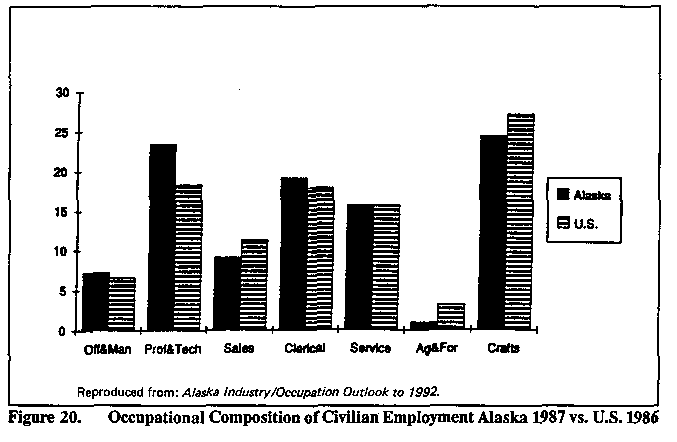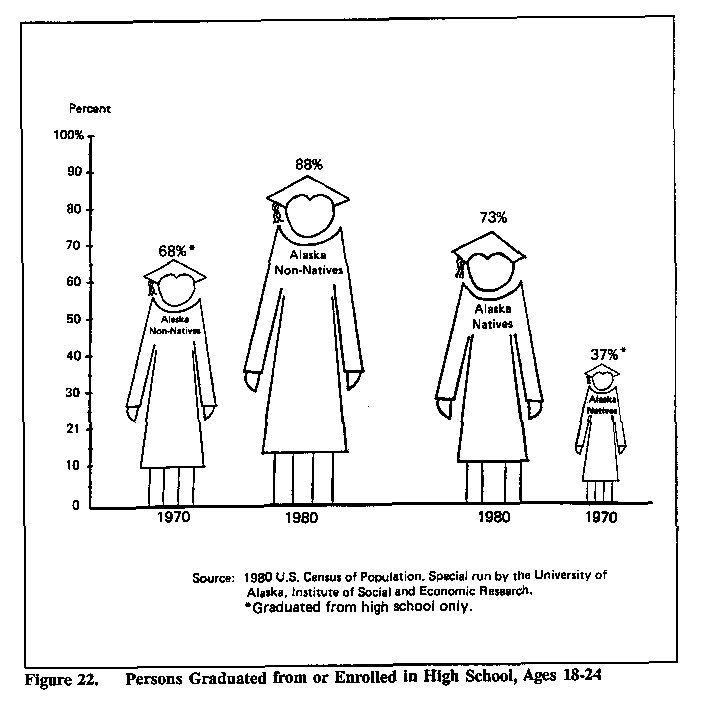
The AFN Report on the Status of Alaska Natives: A Call for Action (pp: 48-58)
Alaska Federation of Natives
411 West Fourth Avenue, Suite 301
Achorage, Alaska 99501
January 1989
[Used with permission of
Alaska Federation of Natives,
Julie Kitka, President]
NATIVE EDUCATION: A DISPROPORTIONATE SHARE OF MEDIOCRITY
In 1983 the National Commission on Excellence in Education characterized the United States as "A Nation at Risk." According to the Commission, "if an unfriendly foreign power had attempted to impose on America the mediocre educational performance that exists today, we might well have viewed it as an act of war." Notwithstanding the cherished belief that "all, regardless of race or class or economic status, are entitled to a fair chance…for developing their individual powers of mind and spirit to the utmost," the commission argued that "our society and its educational institutions seem to have lost sight of the basic purposes of schooling, and of the high expectations and disciplined effort needed to attain them."
Education in Alaska is no exception to the Commission's rule. In particular, the education offered in village grade and high schools must claim a disproportionate share of the nation's educational mediocrity. Educational attainment among Native children falls well below even the norms that the Commission found an unacceptable threat to America's future. In most village schools, Native students test between the 25th and 30th percentiles, a level far below the national norm. As a result, Native children who attend village schools are being denied the Commission's promise that "all children, by virtue of their own efforts, competently guided, can hope to attain the mature and informed judgment needed to secure gainful employment and to manage their own lives, thereby serving not only their own interests but also the progress of society itself."
EDUCATION AND EMPLOYMENT
As the Commission noted, without gainful employment an individuals ability to manage his or her own life is undermined, and the progress of society is endangered. But to compete successfully in the Alaska labor market against non-Natives, Natives must be on equal educational footing. It is a harsh but real truth that, even where jobs are available, substandard education denies many young Native adults the opportunity to secure gainful employment, just as it denied the same opportunity to many of their parents and grandparents.
The preceding section documented an omnipresent reality: a majority of Alaska Natives live in remote villages where few jobs are available, far fewer than the number of individuals who want to work. It also described why the potential for increasing the number of jobs in rural villages is extremely limited. Given these grim facts, few village economies will be able to provide jobs for the growing number of young Native adults.
The unavoidable result is that, in the years ahead, most young Native adults who want work will have to move from their villages to locations where jobs exist, and there they will find themselves competing in the labor market with non-Natives. Thus, at a minimum, village grade and high schools should equip Native students with skills adequate to compete with their non-Native counterparts, whether for work or in the pursuit of post-secondary vocational or college education. While such a modest standard of educational attainment does not fully respond to the Commission's challenge, it will at least enable young Natives to begin their adult lives on an educational par with other Americans.
COMPETING IN THE ALASKA LABOR MARKET
Competing in Alaska's labor market requires more education than competing in labor markets elsewhere in the nation. Figure 20 reveals that the Alaska work force is more professional and technically equipped than the national work force. In 1980 the Bureau of the Census reported that, in Alaska, on average, adults over 25 years of age had 12.8 years of education, compared to the national average of 12.5 years. Similarly, 88 percent of the members of this age group had graduated from high school, compared to the national average of 67 percent.

Alaska Natives face serious disadvantage in competing with non-Natives for managerial, professional and technical jobs that require a college education. In 1980, the percentage of the adult non-Native population that had college degrees was five times the percentage of the adult Native population with degrees. Figure 21 illustrates the competitive disadvantage. Slightly less that 25 percent of white residents 25 years of age or older had college degrees compared to less than 5 percent of Alaska Natives. Asian adults with college degrees were comparable to whites. Black residents had acquired college degrees at a rate twice that of Natives.
 Prior to
1970 when the majority of Natives lived in rural villages without
high schools, only one in five Native adults had a high school
education. Figure 21 illustrates the limited access that Native
students in rural villages had to high schools prior to 1970.
Over 50 percent of the rural adult population had no high school
experience, less than 22 percent had high school diplomas and the
median number of years of school completed by rural Natives was
7.5.
Prior to
1970 when the majority of Natives lived in rural villages without
high schools, only one in five Native adults had a high school
education. Figure 21 illustrates the limited access that Native
students in rural villages had to high schools prior to 1970.
Over 50 percent of the rural adult population had no high school
experience, less than 22 percent had high school diplomas and the
median number of years of school completed by rural Natives was
7.5.
VILLAGE HIGH SCHOOLS ARE CLOSING THE GRADUATION GAP
In the 1970s the State of Alaska began building village high schools. As a result, Native access to secondary education significantly improved, as did the percentage of young Native adults with high school diplomas. Figure 22 indicates that by 1984 approximately 73 percent of Natives between 18 and 24 years of age were either attending high school or had graduated, at a time when 88 percent of their non-Native counterparts were either attending high school or had graduated. The 1984 figures are a significant improvement from 1970 when only 37 percent of Natives had graduated from high school, compared to 68 percent of non-Natives.
Of the 73 percent of Natives between 18 and 24 years of age who had graduated or were attending high school in 1980, 14 percent were still attending school, compared to 3 percent of non-Natives the same age, an in-school rate for Natives almost three times that of non-Natives. These data suggest that Native students are either taking longer to complete their studies or starting high school later than their non-Native counterparts.

Although substantial progress has been made in increasing the Native high school graduation rate, the Native drop-out rate is more than twice the non-Native drop-out rate, 27 percent compared to 12 percent. But the Native drop-out rate may be declining. A 1984 University of Alaska study found that in two-thirds of small village high schools the reported drop-out rate was less than 10 percent. However, the gain may be being partially offset by the continued high Native drop-out rate in urban high schools. Anchorage, Alaska's largest school district, continues to report a 30 percent Native drop-out rate, and high schools in Fairbanks, Juneau and other urban areas also report high Native drop-out rates.
The 1990 Census will likely report that the gap between Natives and non-Natives who complete high school has continued to narrow. But the continued high Native drop-out rate in urban high schools, where a majority of Native students now attend school, suggests that during the 1980s the narrowing has been modest and that a significant gap will persist until the Native drop-out rates in urban high schools are reduced.
SMALL VILLAGE HIGH SCHOOLS
Much of the improvement in closing the high school graduation gap can be directly attributed to the State of Alaska's village high school construction program. The program began in 1976 when the State settled a lawsuit filed on behalf of Native students who had been compelled to attend high school in regional boarding home programs far from home. As part of the settlement, the State agreed to construct and operate a high school in any village with eight or more high school age students, a commitment that resulted in the construction and operation of 126 schools. Table 2 summarizes the number and size of small high schools, only 36 of which predated settlement of the litigation.

Eight years after the new village high schools began opening, the number of Natives graduating from small village high schools had increased more than three-fold. Indeed, annual increases in the number of Native students attending and graduating from high school corresponded closely with the village high school construction schedule. By 1984 approximately 1,000 students were annually graduating from small village high schools. If the schools had not been built, some students would have graduated from one of the regional high school boarding home programs, but by no means would all have done so.

NATIVE PROGRESS IN POST-SECONDARY EDUCATION
Figure 24 illustrates a logical progression from the observations reported in Figure 3. As more Natives graduate from high school, more Natives are attending college.
In 1980 Natives between 20 and 29 years of age were approximately 13 percent of that age-group statewide. Natives comprised 11 percent of Alaska residents between 20 and 29 years of age with associate degrees, 5.4 percent of baccalaureate degrees, 2.2 percent of master's degrees, and no PhD's. These percentages pose a clear challenge to village high school teachers and administrators, since a solid high school education is a prerequisite to academic success in college.

After high school, post-secondary education usually proceeds on a dual track, one leading to vocational/associate degrees, the other to baccalaureate degrees. Baccalaureate degree study usually requires more academic preparation. The fact that Natives are significantly under-represented among holders of baccalaureate degrees indicates that many Native high school graduates are not sufficiently prepared to succeed in a four-year program...